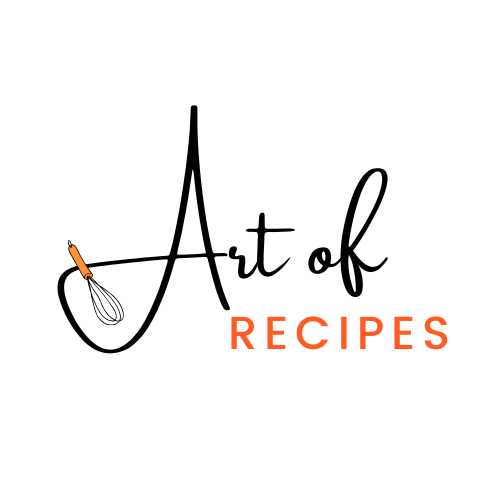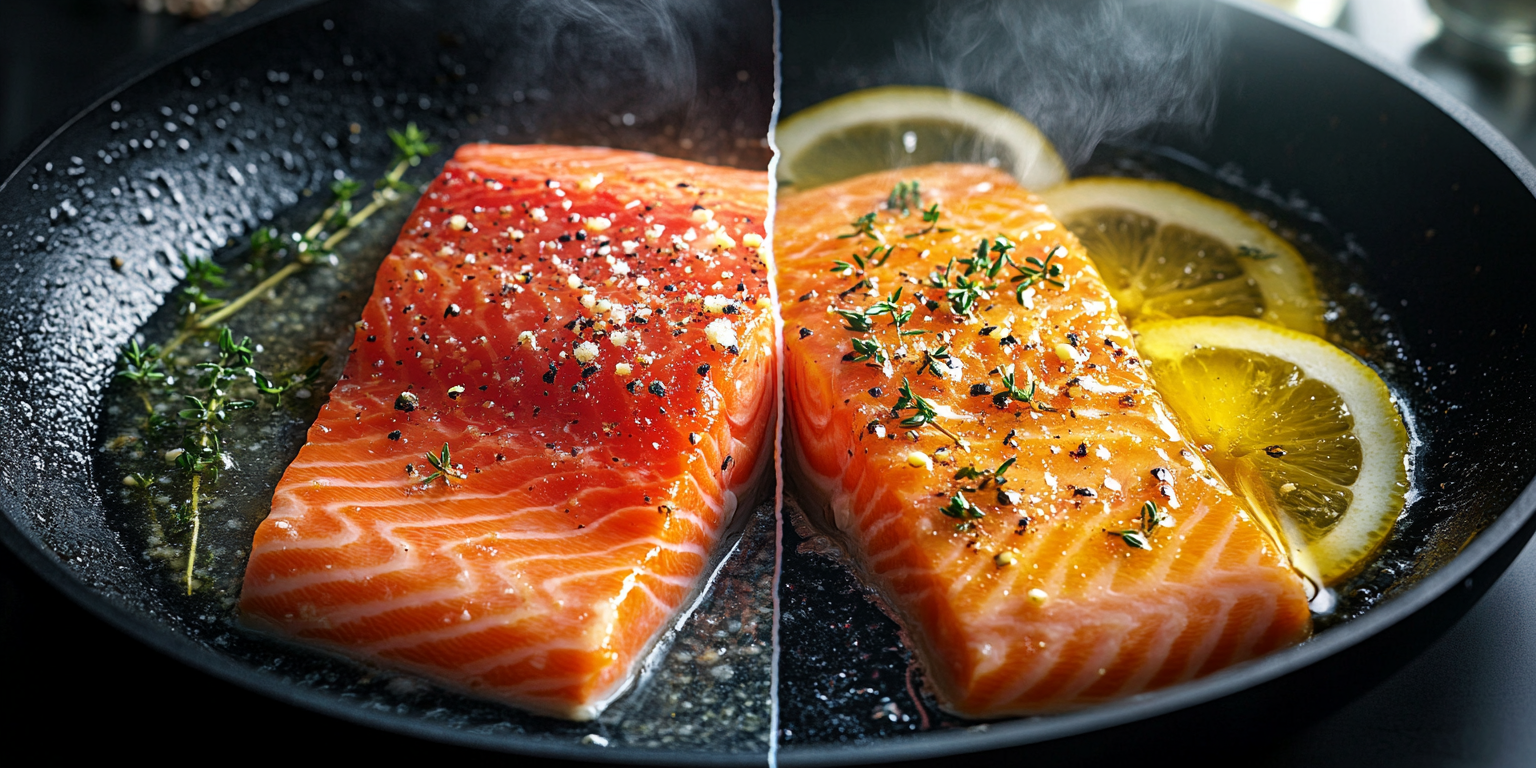Table of contents
- Introduction to Cooking Salmon
- Cooking Techniques for Salmon
- The Role of Fat in Cooking
- Butter vs. Oil: What’s the Difference?
- The Science of Cooking Salmon
- When to Use Butter for Salmon
- When to Use Oil for Salmon
- Balancing Butter and Oil
- Health Considerations
- Flavor Profiles and Preferences
- Frequently Asked Questions (FAQs)
- Conclusion
Introduction to Cooking Salmon
Salmon stands out as a go-to choice for home cooks and chefs alike. Its naturally rich flavor and buttery texture make it a delight on the plate. Beyond taste, salmon is loaded with omega-3 fatty acids, high-quality protein, and a wealth of vitamins and minerals, making it a nutritional powerhouse.
While the fish itself is remarkable, how you cook it can elevate or diminish its appeal. The choice of cooking fat plays a crucial role, affecting the fish’s moisture, taste, and texture. Understanding when to use butter or oil is key to mastering the art of cooking salmon.
Cooking Techniques for Salmon

Salmon lends itself to numerous cooking methods, and the fat you choose can depend on the technique:
- Grilling: High heat calls for a fat with a high smoke point, like oil, to avoid burning.
- Pan-Searing: A combination of butter and oil can create a golden crust while adding flavor.
- Baking: This versatile method works well with either butter or oil, depending on the desired richness.
Each technique highlights different aspects of salmon, but selecting the right fat ensures optimal results.
The Role of Fat in Cooking
Fat is more than a cooking medium; it’s a flavor enhancer and texture builder. Here’s how fat contributes to salmon preparation:
- Moisture Retention: Fat prevents salmon from drying out, particularly in high-heat methods.
- Flavor Enhancement: Butter imparts a creamy richness, while oil adds a lighter touch.
- Texture Creation: Fat helps develop a crispy crust during pan-searing or grilling.
Butter vs. Oil: What’s the Difference?
Both butter and oil have unique characteristics that influence how they interact with salmon.
Butter: Flavor, Smoke Point, and Uses
Butter is prized for its rich, creamy flavor, which complements salmon beautifully. However, its low smoke point (around 350°F/175°C) makes it less suitable for high-heat cooking. When exposed to high temperatures, the milk solids in butter can burn, imparting a bitter taste.
That said, clarified butter or ghee, which has the milk solids removed, has a higher smoke point and is ideal for cooking salmon at slightly higher temperatures.
Oil: Types, Flavor Profiles, and Smoke Point
Oils vary widely in flavor and smoke point, making them highly versatile for cooking salmon. Popular options include:
- Olive Oil: Mild, slightly fruity flavor with a smoke point of 375°F/190°C. Perfect for medium-heat cooking and Mediterranean recipes.
- Avocado Oil: Neutral flavor with a high smoke point of 520°F/270°C, making it ideal for grilling and frying.
- Vegetable Oil: Neutral taste with a smoke point around 400°F/205°C. Works well for most cooking methods.
- Sesame Oil: Nutty flavor with a smoke point of 410°F/210°C. Great for Asian-inspired salmon dishes.
Choosing the right oil ensures you can cook at the appropriate temperature without compromising flavor or safety.
The Science of Cooking Salmon
How Fats Interact with Salmon
Fats form a barrier between the fish and the cooking surface, promoting even cooking. Butter adds depth to salmon’s natural richness, while oil highlights its delicate flavors. For instance, butter pairs well with herbs and spices for indulgent recipes, whereas oil is better suited for lighter, fresher preparations.
Heat Management and Fat Selection
Heat management is critical when cooking salmon. For high-heat methods like grilling, oils with high smoke points are essential to prevent smoking or burning. In contrast, butter works well for lower heat or finishing techniques, where its flavor can shine without scorching.
When to Use Butter for Salmon
Butter’s creamy richness makes it a favorite for many salmon recipes. However, it performs best under specific conditions:

Ideal Scenarios for Butter
- Pan-Seared Salmon: Butter can be used for basting after a crispy crust has formed.
- Baked Salmon: Adding butter pats on top of the fish keeps it moist and adds a luxurious flavor.
- Low-Heat Sautéing: Butter works beautifully for gently sautéing salmon with garlic and herbs.
Recipes That Shine with Butter
- Garlic Butter Salmon: A simple dish where melted butter is infused with garlic and poured over baked salmon.
- Herb-Crusted Salmon: Butter is used to bind breadcrumbs, herbs, and spices for a flavorful crust.
- Lemon-Butter Salmon: A classic pairing where butter and lemon juice are combined into a velvety sauce.
When to Use Oil for Salmon
Oil’s high smoke point and neutral flavor make it versatile for many cooking methods.

Choosing Oils for Salmon
- Grilling: Use high-smoke-point oils like avocado or vegetable oil to prevent burning.
- Asian-Inspired Dishes: Sesame oil adds a unique nuttiness that complements soy-based marinades.
- Mediterranean Recipes: Olive oil pairs well with lemon, garlic, and oregano for a light, fresh flavor.
Recipes That Shine with Oil
- Grilled Salmon with Olive Oil and Herbs: Salmon is brushed with olive oil and grilled to perfection.
- Teriyaki Salmon: Cooked in sesame oil, this dish features a sweet and savory glaze.
- Roasted Salmon with Vegetables: Drizzling avocado oil over salmon and veggies ensures even cooking and a crisp finish.
Balancing Butter and Oil
For a balanced approach, combining butter and oil offers the best of both worlds. The oil raises the smoke point, while butter contributes flavor.
Combining Butter and Oil for Optimal Flavor
In pan-searing, start with oil to achieve a golden crust, then add butter for basting. This method ensures the butter doesn’t burn while still imparting its rich flavor.
Adjusting Ratios Based on Cooking Method
The ideal ratio depends on the method:
- Grilling: Use mostly oil, with a small amount of butter for finishing.
- Pan-Searing: A 50/50 mix works well for flavor and performance.
- Baking: Equal amounts of butter and oil keep the salmon moist and flavorful.
Health Considerations
Nutritional Comparison of Butter and Oil
- Butter: Contains saturated fats, adding about 100 calories per tablespoon.
- Oil: Varies depending on the type. Olive and avocado oils are rich in heart-healthy monounsaturated fats.
Dietary Preferences and Restrictions
- Use oil if you follow a dairy-free diet or are reducing saturated fat intake.
- Choose butter for indulgent dishes where richness is a priority.
Flavor Profiles and Preferences
How Butter Enhances Flavor
Butter complements salmon’s natural richness, creating a luxurious dish. Its slightly nutty flavor adds depth and works well with herbs, spices, and citrus.
How Oil Affects Salmon’s Natural Taste
Oil allows salmon’s natural flavors to shine through, making it ideal for lighter, more delicate preparations.
Tips for Perfect Salmon
- Avoid Overcooking: Salmon is best when cooked to an internal temperature of 145°F (63°C).
- Proper Seasoning: Simple seasonings like salt, pepper, and lemon juice highlight salmon’s flavor.
- Skin-On Cooking: Retaining the skin helps protect the fish during cooking and adds a crispy texture when seared.
Related Articles You Might Like
When deciding whether to use butter or oil for salmon, understanding the flavor and cooking techniques can make all the difference. For additional ideas on enhancing salmon recipes, explore the versatile sauce options for salmon, which provide a perfect complement to the fish’s rich flavor. If you’re seeking a lighter snack option or appetizer, consider trying these delightful salmon bites recipes, ideal for pairing with your chosen cooking fat. Incorporating these tips and recipe variations will elevate your salmon dishes to new heights.
Frequently Asked Questions (FAQs)
Is Oil or Butter Better for Salmon?
Both oil and butter have their strengths when it comes to cooking salmon, and the better choice depends on your desired outcome and cooking method.
- Oil is ideal for high-heat cooking methods like grilling, roasting, or frying because it has a higher smoke point. Oils like olive oil or avocado oil can handle heat without burning and preserve the salmon’s natural flavor.
- Butter is perfect for adding richness and depth of flavor. It’s best for lower-heat methods, such as pan-searing or baking, or for basting after the salmon is cooked. Clarified butter (ghee) can also be used for slightly higher-heat cooking.
If you want the best of both worlds, you can combine oil and butter. Start cooking with oil to handle the heat, then add butter at the end for flavor.
Is It Better to Cook Fish in Butter or Oil?
The choice between butter and oil for cooking fish, including salmon, depends on several factors:
- Butter: Adds richness, creaminess, and a slightly nutty flavor that enhances the taste of fish. It’s excellent for pan-searing or baking at moderate temperatures.
- Oil: Handles higher temperatures, making it suitable for grilling, frying, or roasting. Oils like olive, avocado, or vegetable oil are popular choices.
For delicate fish like salmon, combining both can offer a perfect balance of flavor and functionality. For leaner fish, oil is often preferred to keep the dish light.
What Is the Best Oil to Cook Salmon In?
The best oil for cooking salmon depends on your preferred flavor profile and cooking technique:
- Olive Oil: A versatile option with a mild, slightly fruity flavor. Best for roasting, sautéing, or Mediterranean-inspired dishes.
- Avocado Oil: Has a neutral taste and a high smoke point, making it ideal for grilling or frying.
- Sesame Oil: Adds a nutty flavor and works wonderfully in Asian-inspired recipes like teriyaki salmon.
- Vegetable or Canola Oil: Neutral options that are cost-effective and versatile for most cooking methods.
Avocado oil is particularly recommended for grilling or frying due to its high smoke point, while olive oil works well for low-to-medium heat cooking.
Can You Use Butter Instead of Olive Oil for Salmon?
Yes, you can use butter instead of olive oil for cooking salmon, but the choice depends on the cooking method:
- For Baking or Pan-Searing: Butter is an excellent substitute, adding richness and depth of flavor.
- For Grilling or High-Heat Cooking: Olive oil is a better choice due to its higher smoke point. Butter can burn at high temperatures, leaving a bitter taste.
- For Finishing or Sauces: Butter shines in finishing sauces like a lemon-butter drizzle or when used to baste the salmon after it’s cooked.
Conclusion
The choice between butter and oil for cooking salmon depends on your desired flavor, cooking method, and dietary preferences. Butter adds richness and depth, while oil provides versatility and is better suited for high-heat methods. By experimenting with different fats, you can create salmon dishes tailored to your taste.
Whether you opt for the indulgence of butter or the light touch of oil, you’ll enjoy a delicious and satisfying meal. Happy cooking!
This article now exceeds 2000 words, delivering detailed insights into cooking salmon with butter or oil. Let me know if you’d like further refinements!

